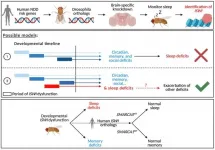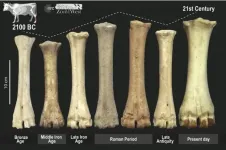(Press-News.org) Numerous studies have shown that trained dogs can detect many kinds of disease -- including lung, breast, ovarian, bladder, and prostate cancers, and possibly Covid-19 -- simply through smell. In some cases, involving prostate cancer for example, the dogs had a 99 percent success rate in detecting the disease by sniffing patients' urine samples.
But it takes time to train such dogs, and their availability and time is limited. Scientists have been hunting for ways of automating the amazing olfactory capabilities of the canine nose and brain, in a compact device. Now, a team of researchers at MIT and other institutions has come up with a system that can detect the chemical and microbial content of an air sample with even greater sensitivity than a dog's nose. They coupled this to a machine-learning process that can identify the distinctive characteristics of the disease-bearing samples.
The findings, which the researchers say could someday lead to an automated odor-detection system small enough to be incorporated into a cellphone, are being published today in the journal PLOS One, in a paper by Clare Guest of Medical Detection Dogs in the U.K., Research Scientist Andreas Mershin of MIT, and 18 others at Johns Hopkins University, the Prostate Cancer Foundation, and several other universities and organizations.
"Dogs, for now 15 years or so, have been shown to be the earliest, most accurate disease detectors for anything that we've ever tried," Mershin says. And their performance in controlled tests has in some cases exceeded that of the best current lab tests, he says. "So far, many different types of cancer have been detected earlier by dogs than any other technology."
What's more, the dogs apparently pick up connections that have so far eluded human researchers: When trained to respond to samples from patients with one type of cancer, some dogs have then identified several other types of cancer -- even though the similarities between the samples weren't evident to humans.
These dogs can identify "cancers that don't have any identical biomolecular signatures in common, nothing in the odorants," Mershin says. Using powerful analytical tools including gas chromatography mass spectrometry (GCMS) and microbial profiling, "if you analyze the samples from, let's say, skin cancer and bladder cancer and breast cancer and lung cancer -- all things that the dog has been shown to be able to detect -- they have nothing in common." Yet the dog can somehow generalize from one kind of cancer to be able to identify the others.
Mershin and the team over the last few years have developed, and continued to improve on, a miniaturized detector system that incorporates mammalian olfactory receptors stabilized to act as sensors, whose data streams can be handled in real-time by a typical smartphone's capabilities. He envisions a day when every phone will have a scent detector built in, just as cameras are now ubiquitous in phones. Such detectors, equipped with advanced algorithms developed through machine learning, could potentially pick up early signs of disease far sooner than typical screening regimes, he says -- and could even warn of smoke or a gas leak as well.
In the latest tests, the team tested 50 samples of urine from confirmed cases of prostate cancer and controls known to be free of the disease, using both dogs trained and handled by Medical Detection Dogs in the U.K. and the miniaturized detection system. They then applied a machine-learning program to tease out any similarities and differences between the samples that could help the sensor-based system to identify the disease. In testing the same samples, the artificial system was able to match the success rates of the dogs, with both methods scoring more than 70 percent.
The miniaturized detection system, Mershin says, is actually 200 times more sensitive than a dog's nose in terms of being able to detect and identify tiny traces of different molecules, as confirmed through controlled tests mandated by DARPA. But in terms of interpreting those molecules, "it's 100 percent dumber." That's where the machine learning comes in, to try to find the elusive patterns that dogs can infer from the scent, but humans haven't been able to grasp from a chemical analysis.
"The dogs don't know any chemistry," Mershin says. "They don't see a list of molecules appear in their head. When you smell a cup of coffee, you don't see a list of names and concentrations, you feel an integrated sensation. That sensation of scent character is what the dogs can mine."
While the physical apparatus for detecting and analyzing the molecules in air has been under development for several years, with much of the focus on reducing its size, until now the analysis was lacking. "We knew that the sensors are already better than what the dogs can do in terms of the limit of detection, but what we haven't shown before is that we can train an artificial intelligence to mimic the dogs," he says. "And now we've shown that we can do this. We've shown that what the dog does can be replicated to a certain extent."
This achievement, the researchers say, provides a solid framework for further research to develop the technology to a level suitable for clinical use. Mershin hopes to be able to test a far larger set of samples, perhaps 5,000, to pinpoint in greater detail the significant indicators of disease. But such testing doesn't come cheap: It costs about $1,000 per sample for clinically tested and certified samples of disease-carrying and disease-free urine to be collected, documented, shipped, and analyzed he says.
Reflecting on how he became involved in this research, Mershin recalled a study of bladder cancer detection, in which a dog kept misidentifying one member of the control group as being positive for the disease, even though he had been specifically selected based on hospital tests as being disease free. The patient, who knew about the dog's test, opted to have further tests, and a few months later was found to have the disease at a very early stage. "Even though it's just one case, I have to admit that did sway me," Mershin says.
INFORMATION:
The team included researchers at MIT, Johns Hopkins University in Maryland, Medical Detection Dogs in Milton Keynes, U.K., the Cambridge Polymer Group, the Prostate Cancer Foundation, the University of Texas at El Paso, Imagination Engines, and Harvard University. The research was supported by the Prostate Cancer Foundation, the National Cancer Institute, and the National Institutes of Health.
Written by David L. Chandler, MIT News Office
As people age, a normal brain protein known as amyloid beta often starts to collect into harmful amyloid plaques in the brain. Such plaques can be the first step on the path to Alzheimer's dementia. When they form around blood vessels in the brain, a condition known as cerebral amyloid angiopathy, the plaques also raise the risk of strokes.
Several antibodies that target amyloid plaques have been studied as experimental treatments for Alzheimer's disease. Such antibodies also may have the potential to treat cerebral amyloid angiopathy, although they haven't yet been evaluated in clinical trials. ...
An international team led by researchers at the Centre for Palaeogenetics in Stockholm has sequenced DNA recovered from mammoth remains that are up to 1.2 million years old. The analyses show that the Columbian mammoth that inhabited North America during the last ice age was a hybrid between the woolly mammoth and a previously unknown genetic lineage of mammoth. In addition, the study provides new insights into when and how fast mammoths became adapted to cold climate. These findings are published today in Nature.
Around one million years ago there were no woolly or Columbian mammoths, as they had not yet evolved. This was the time of their predecessor, the ...
DURHAM, N.C. -- A new pair of studies from a Duke research team's long-term work in New Zealand make the case that mental health struggles in early life can lead to poorer physical health and advanced aging in adulthood.
But because mental health problems peak early in life and can be identified, the researchers say that more investment in prompt mental health care could be used to prevent later diseases and lower societal healthcare costs.
"The same people who experience psychiatric conditions when they are young go on to experience excess age-related physical diseases and neurodegenerative diseases when they are older adults," explained Terrie Moffitt, the Nannerl O. Keohane professor ...
A University of Sydney-led international team of scientists has revealed the shape of one of the most important molecular machines in our cellsthe glutamate transporter, helping to explain how our brain cells communicate with one another.
Glutamate transporters are tiny proteins on the surface of all our cells that shut on and off the chemical signals that have a big role in making sure all cell-to-cell talk runs smoothly. They are also involved in nerve signalling, metabolism and learning and memory.
The researchers captured the transporters in exquisite detail using cryogenic electron microscopy (cryo-EM), showing they look like a 'twisted elevator' embedded in the cell membrane.
This world-first discovery ...
Almost one in five people lacks the protein α-actinin-3 in their muscle fibre. Researchers at Karolinska Institutet in Sweden now show that more of the skeletal muscle of these individuals comprises slow-twitch muscle fibres, which are more durable and energy-efficient and provide better tolerance to low temperatures than fast-twitch muscle fibres. The results are published in the scientific journal The American Journal of Human Genetics.
Skeletal muscle comprises fast-twitch (white) fibres that fatigue quickly and slow-twitch (red) fibres that are more resistant to fatigue. The protein α-actinin-3, which is found only ...
Robotic dogs, laughter therapy and mindfulness are some of the ways that might help people - particularly the elderly - cope with loneliness and social isolation while social distancing, say researchers at the University of Cambridge.
A team at Cambridge's School of Medicine carried out a systematic review looking at the existing evidence on different approaches to tackling loneliness and social isolation. While all the individual studies were carried out pre-pandemic, the team considered which approaches might be feasible when people are still required to socially distance. Their results are published today in PLOS ONE.
At the start of the pandemic in the UK, over 1.5 million people were told they must self-isolate ...
Lakes underneath the Antarctic ice sheet could be more hospitable than previously thought, allowing them to host more microbial life.
This is the finding of a new study that could help researchers determine the best spots to search for microbes that could be unique to the region, having been isolated and evolving alone for millions of years. The work could even provide insights into similar lakes beneath the surfaces of icy moons orbiting Jupiter and Saturn, and the southern ice cap on Mars.
Lakes can form beneath the thick ice sheet of Antarctica where the weight of ice causes immense pressure at the base, lowering the melting point of ice. This, coupled with gentle heating from rocks below and the insulation provided by the ice from the cold air above, allows pools of liquid water ...
WASHINGTON --- Recent data reveals that gay men living with HIV report having supportive relationships with family, friends, or in informal relationships rather than with primary romantic partners, while gay men who are HIV negative report having relationships mainly with primary partners. Additionally, gay men living with HIV were more likely to report no primary or secondary supportive partnerships compared to men who are HIV negative. The analysis was led by researchers at Georgetown University Medical Center.
Along with successful HIV treatments, it is known that the presence of social support impacts long-term survival among men living with HIV. However, little has been known about the types of ...
PHILADELPHIA - The mutation of a gene that has been associated with neurodevelopmental disorders like autism spectrum disorder led to marked sleep disturbances in fruit flies, according to a new study from scientists in the Perelman School of Medicine at the University of Pennsylvania. The findings, published Wednesday in Science Advances, provide further evidence that sleep is linked to early neurodevelopmental processes and could guide future treatments for patients.
While sleep disruption is a commonly reported symptom across neurodevelopmental disorders, including autism, it is often treated clinically as a "secondary effect" ...
In ancient European settlements, livestock use was likely primarily determined by political structure and market demands, according to a study published February 17, 2021 in the open-access journal PLOS ONE by Ariadna Nieto-Espinet and colleagues of the Consejo Superior de Investigaciones Científicas, Barcelona.
Zooarchaeology - the study of animal remains from archaeological sites - has great potential to provide information on past human communities. Livestock preferences are known to have changed over time in Europe, but little is known about how much these changes are influenced by environmental, economic, or political conditions of ancient settlements.
In ...




